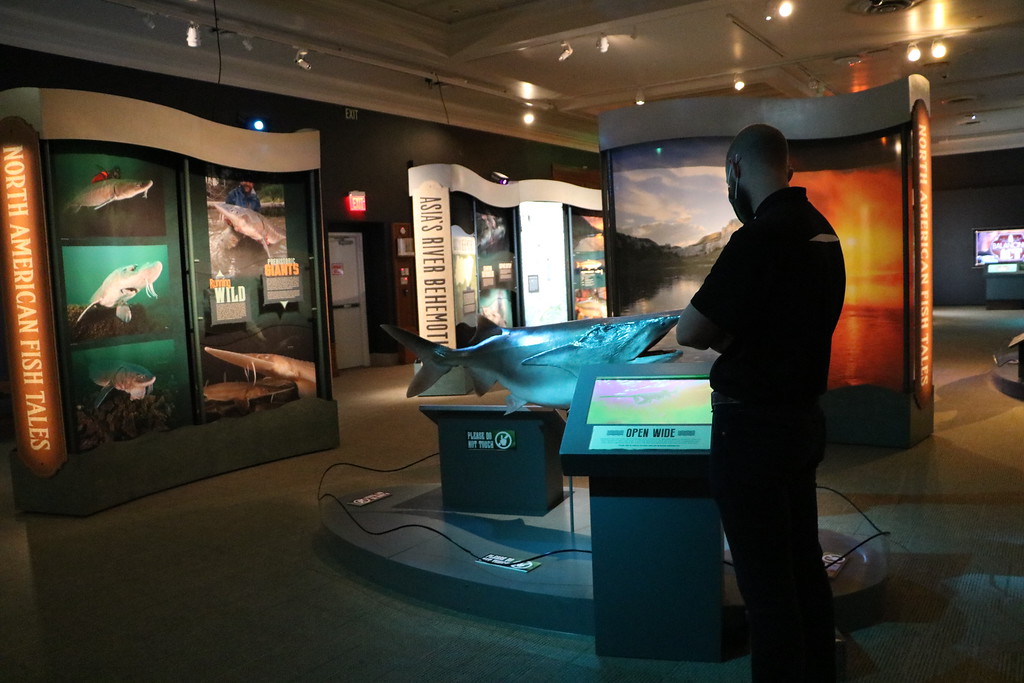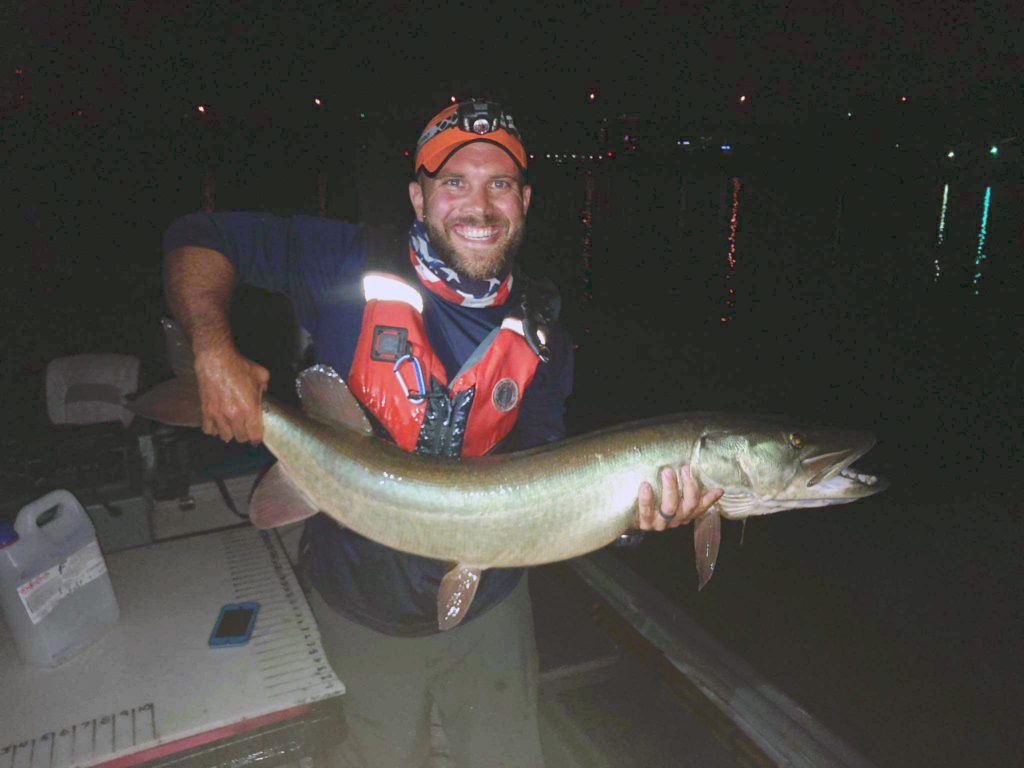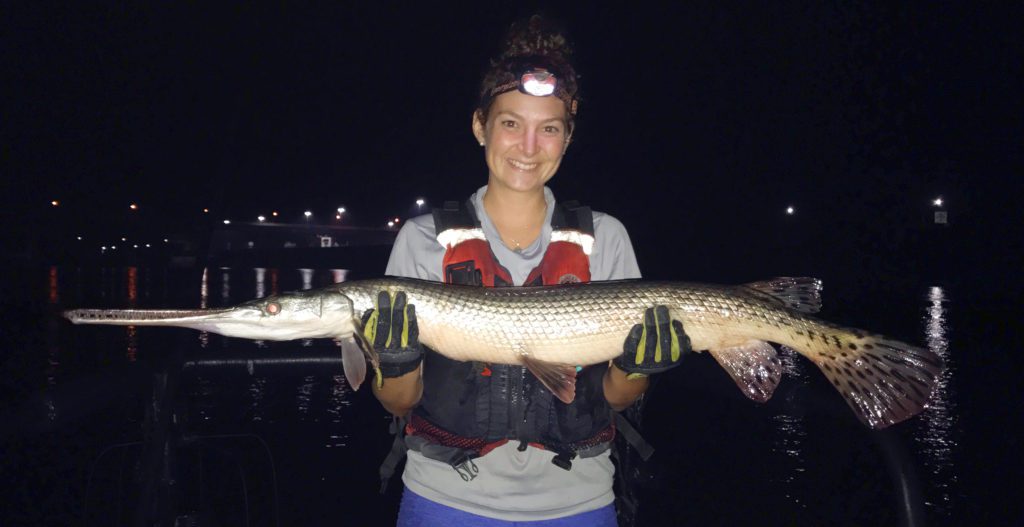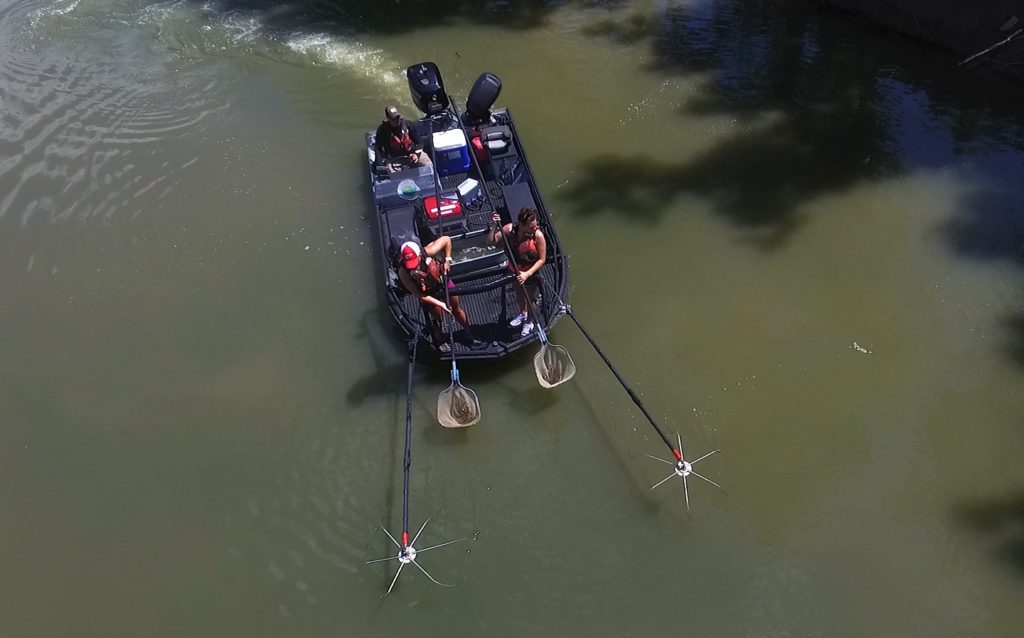by Patrick McShea
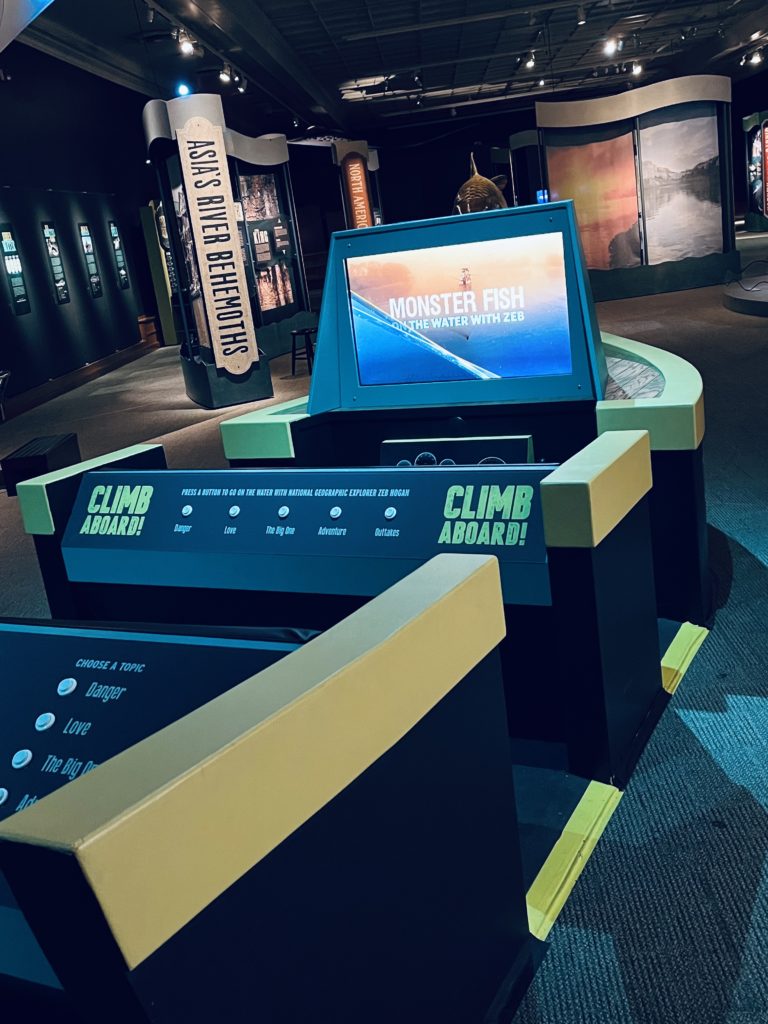
If your work involves the study of river fish, boats are essential tools. In Monster Fish: In Search of the Last River Giants, an exhibition developed and travelled by National Geographic, the vital role of watercraft as research platforms is acknowledged through an interactive display that resembles a boat. Here visitors are welcomed aboard a simulated 15-foot vessel to sit on bow-facing bench seats and watch on-the-water video clips of big fish and Dr. Zeb Hogan, host of the popular Nat Geo Wild show.
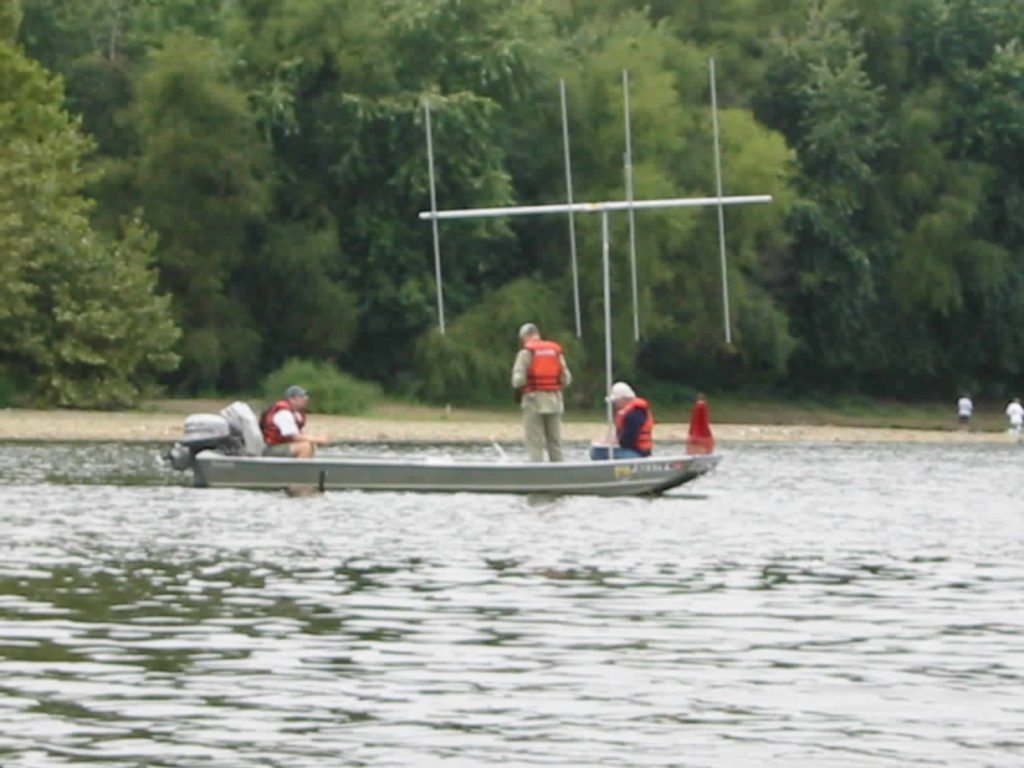
Back in 2002 and 2003, when fisheries biologist Patrick Barry and a small team of assistants relied upon a similar-sized boat to study the movements of American Paddlefish in Pittsburgh’s rivers, an antenna towered 15 feet above the craft. “Other people on the rivers certainly noticed us when we were out on the water.” Barry explains, “The antenna made us pretty conspicuous.”
There was nothing secret about the research, which was a collaborative effort involving the Pennsylvania Fish and Boat Commission, U.S. Geological Survey, U.S. Army Corps of Engineers, West Virginia Division of Natural Resources, California University of Pennsylvania, and Penn State University. There was, however, little local public knowledge about paddlefish, a native species that disappeared from the river system here in the 1920’s, and a creature whose fossil lineage dates back some 100 million years. Barry was then a fisheries science graduate student at Penn State, and his thesis research was intended to shed light on the limited success of paddlefish reintroduction efforts conducted by the PA Fish and Boat Commission during the early 1990s.
The project included targeted public outreach efforts. Barry created a bright yellow mini-poster bearing the headline “Have You Seen This Fish?” above a picture of his long-snouted thesis subject, and placed dozens of copies at marinas, boat launches, and fishing tackle shops along the sections of the Allegheny River and Ohio River in his study area. A pair of impressive paddlefish facts were shared below the picture – the creature’s potential to attain a length of seven feet, and a weight of up to 100 pounds – followed by a plea to release any paddlefish soon after capture, and to contact Barry with information about the circumstances of the catch.
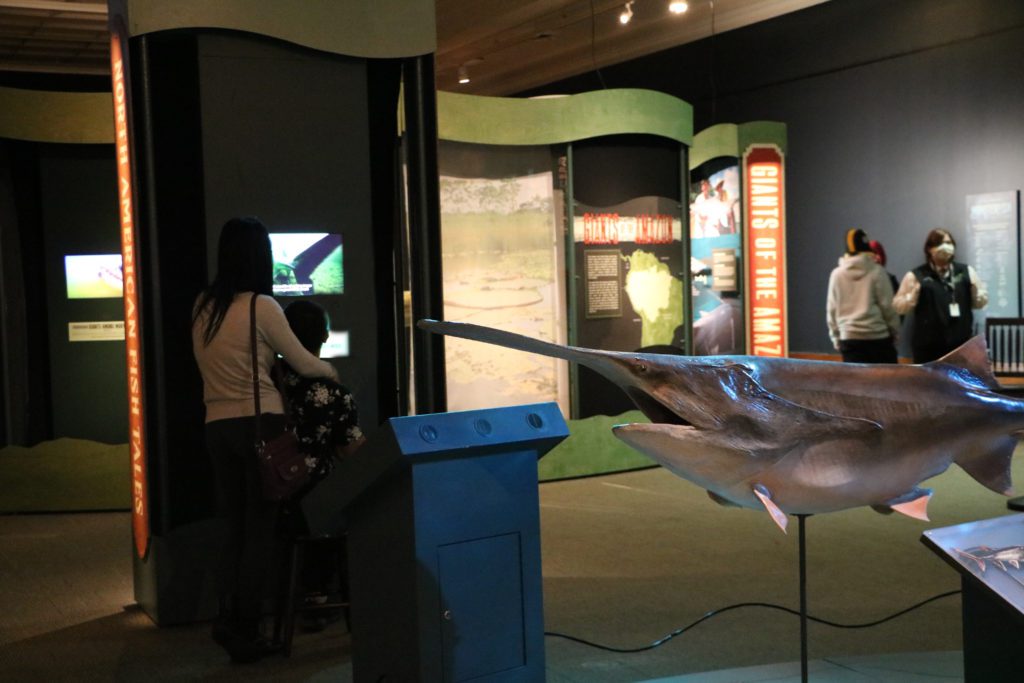
Visitors to Monster Fish are presented with far more information about the big river resident known to science as Polyodon spathula. A six-foot long American Paddlefish replica is the centerpiece of the exhibition’s North American sector, owing to the species’ wide distribution in most of the larger rivers in the Mississippi River Watershed. Off the model’s left flank is an information panel describing the eye-catching long bill as an extraordinary sensory organ, explaining the species’ plankton diet, and introducing a Yangtze River relative last seen in 2003, the Chinese Paddlefish. Off the fish’s right flank a video display titled “OPEN WIDE” shows how the creature’s widely opened mouth and comb-like bony interior function as an effective plankton-capturing screen.
The fish Barry worked with were far smaller than the exhibit model. Over the two years of his study he and his team released a total of 66 hatchery-reared juvenile paddlefish ranging, in “eye-to-tail length,” from 10 to 12 inches. Each had been fitted with pencil-thin battery-powered radio transmitters that weighed less than 2% of the fish’s body weight. Releases were staged in late September both years, and Barry’s goal, during the nine weeks following each event was to relocate, with the aid of the boat-mounted antenna, each fish every day. Each relocation, when recorded with the aid of a Global Positioning System (GPS) unit, added important information about dispersal distance, direction of movement, habitat preference, and overall survival.
Today Patrick Barry is Watershed Program Manager for the Bridger Teton National Forest in western Wyoming, where instead of relocating wandering fish, his daily goals are related to the implementation of policy and management of staff to provide clean water and sustainable forests for current and future needs. From his office in Afton, WY during a recent phone conversation he was happy to summarize his findings from Pittsburgh waters nearly two decades ago. He noted that days relocating tagged fish frequently stretched into nights of doing the same, and the routine during the study periods was to “get up the next day, and do it all over again.”
He heard back from people who encountered his yellow mini-posters, and many of their reports reinforced a paddlefish behavior he had observed firsthand. “People in boats saw the fish in places where currents brought nutrient-rich waters up to the sunny surface, but these people were never in metal boats. They’d be in a fiberglass canoe, never an aluminum one. The long snout of the paddlefish contains sensors that can detect the electrical charge of anything metal in the water. You aren’t likely to see one if you’re in a metal-hulled boat.”
When asked about the long-term viability for paddlefish in Pittsburgh area waters, Barry pointed immediately to a longstanding gap in the species’ habitat requirements. “Historically the Pittsburgh’s rivers have been able to flood and recede, a cycle that creates gravel bars in some places. Paddlefish need gravel bars to spawn, and during the study we weren’t able to pinpoint a single suitable spawning spot it in the survey territory.”
Although Barry has worked professionally with our continent’s western trout and salmon species since his months on the water in Pittsburgh, his closing comments convey his continued fascination with paddlefish. “There’s a lot of current interest in the species’ sensory powers. A young paddlefish can detect the wingbeats of a single zooplankton in the water column and adjust its glide pattern to intercept and eat it.”
Patrick McShea works in the Education and Visitor Experience department of Carnegie Museum of Natural History. Museum employees are encouraged to blog about their unique experiences and knowledge gained from working at the museum.
Related Content
The Art of Making Fish Familiar
Rating River Residents On the Monster Scale
March Mammal Madness and Middle School Science Class
Carnegie Museum of Natural History Blog Citation Information
Blog author: McShea, PatrickPublication date: March 29, 2022
